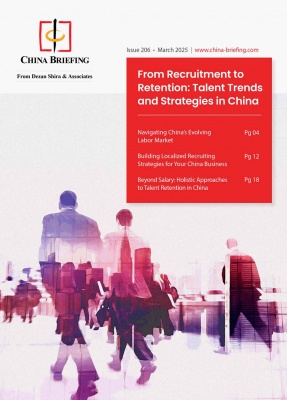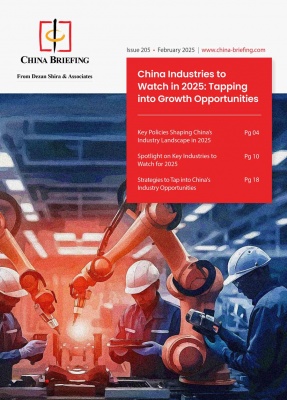Investing in the Future: Opportunities in China’s Humanoid Robotics and Embodied AI Industry
The Chinese humanoid robot market is poised for considerable growth over the next decade, driven by new technological breakthroughs, mature industry chains, investor interest, and favorable government policies. The growth of this emerging industry will also fuel various upstream and downstream sectors, from hardware such as sensors, AI chips, batteries, and electromechanical components, to cutting-edge software such as machine learning, natural language processing, and human-computer interaction. In this article, we provide an overview of the Chinese humanoid robot market and discuss opportunities for investors.
Long confined to the realm of science fiction, humanoid robots are now becoming a reality, thanks to major breakthroughs in artificial intelligence (AI), machine learning, and advanced materials. Innovations in large language models (LLMs) and other AI algorithms, such as OpenAI’s ChatGPT and China’s DeepSeek, have significantly enhanced robots’ ability to process language, understand context, and engage in more human-like interactions
China is rapidly emerging as a global leader in humanoid robotics, fueled by its well-developed industrial supply chains, strong government support, and the rapid growth of domestic AI and robotics firms. Heavy investment from both state-backed and private entities is accelerating innovation, positioning China at the forefront of this transformative technology.
As these innovations continue to evolve, the humanoid robotics industry presents a massive investment opportunity. With demand surging across sectors such as healthcare, manufacturing, and customer service, companies developing cutting-edge AI, robotics hardware, and intelligent automation systems are attracting significant funding. As humanoid robots become increasingly integrated into daily life and business operations, early investors stand to benefit from exponential growth in this high-tech frontier.
China’s robotics industry: An overview
What are humanoid robots and embodied AI?
As opposed to robotic arms or autonomous mobile robots that are already widely used in manufacturing processes, a humanoid robot offers greater versatility by performing complex tasks that require dexterity, adaptability, and interaction within human-centric environments. Humanoid robots usually refer to robots that take on a full or partially humanoid form.
As explained in the Top Ten Trends in Humanoid Robots unveiled at the 2024 World Robot Conference in Beijing, embodied AI (EAI), also sometimes called “embedded AI”, is a high-performance intelligent system that can respond quickly and accurately under dynamic and unpredictable conditions. It is neither a simple computer simulation in a virtual environment nor an electromechanical system that is completely biased towards physical space, but rather a deeply integrated AI-driven system that mimics human cognition, perception, and motor functions to perform sophisticated real-world tasks.
While there is currently no official definition, EAI generally encompasses a broader scope than humanoid robotics. It refers to AI integrated into any physical form, not limited to a humanoid – most commonly seen in autonomous vehicles. In fact, according to the 2025-2030 China Embodied Intelligence Market Survey and Investment Opportunities Research Report from the China Business Industry Research Institute, 44.4 percent of China’s EAI market in 2024 was composed of self-driving cars, with the remaining percentage being robots.
The global and Chinese humanoid robot market
According to the 2024 Humanoid Robot Industry Research Report from the Shenzhen Enterprise Investment Industry Research Institute, predictions regarding the size and projected growth of the humanoid robot market vary widely, partly because there is no one agreed-upon definition of a humanoid robot.
According to a report released by Markets and Markets in January 2025, the global humanoid robot market is expected to grow at a CAGR of 45.5 percent from US$2.03 billion in 2024 to US$13.25 billion in 2029. Meanwhile, Goldman Sachs predicted in February 2024 that the total addressable market for humanoid robots could reach US$38 billion by 2035, with robot shipments reaching 1.4 million units over the same time frame.
Meanwhile, according to the 2024 Humanoid Robot Industry Research Report, the Chinese humanoid robot market is projected to reach approximately RMB 2.76 billion (US$380.3 million) in 2024, RMB 10.471 billion (US$1.4 billion) by 2026, and RMB 75 billion (US$10.3 billion) by 2029. That year, it is projected to account for around 32.7 percent of the global market. By 2035, the market size in China is expected to reach RMB 300 billion (US$41.3 billion).
Morgan Stanley’s “Humanoid 100” list, which lists some of the world’s top public companies currently involved in or exposed to the humanoid market, 56 percent of companies that were confirmed to be involved in humanoid robotics were from China. Morgan Stanley’s research also found that China showed the “most impressive progress in humanoid robotics”, as startups benefit from “established supply chains, local adoption opportunities, and strong degrees of national government support.”
This is further evidenced by the finding that of the robotics unveilings made by these companies since 2022 (through to February 2025 when the report was released), 61 percent came from Chinese companies.
China’s EAI market is projected to grow from RMB 863.4 billion (US$118.96 billion) in 2024 to RMB 973.1 billion (US$134.1 billion) in 2025, per the 2025-2030 China Embodied Intelligence Market Survey and Investment Opportunities Research Report.
Key growth drivers of the humanoid robotics industry
The rapid growth of the humanoid robotics industry is driven by a combination of technological advancements, demographic challenges, and economic factors. Breakthroughs in AI, LLMs, perception systems, and power efficiency have significantly enhanced the capabilities of humanoid robots, making them more versatile, cost-effective, and scalable for real-world applications.
Major strides in AI and generative models have been a key enabler of humanoid robotics development. The release of OpenAI’s ChatGPT in 2022 and China’s DeepSeek in early 2025 sparked a surge in investment and interest, fueling innovation in the sector. Nvidia’s vice president of omniverse and simulation technology, Rev Lebaredian, told CNBC that “breakthroughs in generative AI are bringing 3D perception, control, skill planning, and intelligence to robots.” These advancements have enhanced robots’ ability to perceive, reason, and interact with their environments, making them increasingly viable for complex tasks.
In addition to AI, improvements in robotics engineering, sensory perception, and power efficiency have expanded the practical applications of humanoid robots. Enhanced dexterity, mobility, and cognitive abilities allow these robots to operate in diverse environments, from industrial manufacturing to healthcare and personal assistance.
A key driver of humanoid robotics adoption is the growing global labor shortage, particularly in countries with aging populations and declining birth rates. According to the 2024 Humanoid Robot Industry Research Report, humanoid robots are positioned to address labor gaps by performing tasks that require human-like perception, movement, and decision-making.
This trend is especially pronounced in China, where a shrinking workforce and rising labor costs are driving demand for automation. With fewer young workers entering the labor force, humanoid robots are seen as a long-term solution to sustain economic productivity across industries such as manufacturing, logistics, and elderly care. A report by Goldman Sachs Research estimates that, under ideal conditions where key barriers such as product design, affordability, and public acceptance are overcome, robots could help fill 48 percent to 126 percent of the global labor gap and up to 53 percent of the elderly caregiver shortfall.
China’s leading humanoid robotics companies
China’s humanoid robotics sector is driven by a mix of established tech companies and emerging startups. Many leading players have expanded into humanoid robotics from broader robotics or electronics backgrounds, leveraging their existing expertise and following technological and market trends. At the same time, many of the most innovative companies are smaller start-ups that focus exclusively on humanoid robots to push the boundaries of AI-driven automation and intelligent robotics.
UBTECH Robotics (Shenzhen)
UBTECH is one of China’s most well-known robotics companies, focusing on humanoid robots and AI-powered service robots. It is headquartered in Shenzhen and publicly listed in Hong Kong.
Key product: Walker
UBTECH’s flagship humanoid robot, Walker, is designed for home and office environments. It features:
- 36 high-performance servo joints for fluid movement.
- Multiple sensory systems, including force, vision, hearing, and spatial awareness.
- Autonomous navigation and the ability to interact with humans.
In March 2025, UBTECH announced that it had deployed dozens of Walker S1 robots in the Zeekr EV factory in Ningbo. The robots performed multi-task and multi-site operations, including lifting heavy boxes and handling soft materials. This marks UBTECH’s move into industrial automation.
Unitree Robotics (Hangzhou)
Unitree is known for its high-performance quadruped and humanoid robots. It was one of the first companies to mass-produce high-performance quadruped robots and has since expanded into humanoid robotics.
Key products:
- Unitree H1 – Launched in 2023, this full-size electric-driven humanoid robot stands 180 cm tall and weighs 47 kg.
- Holds the world record for the fastest running humanoid robot, reaching 3.3 m/s.
- Capable of performing backflips.
- Unitree G1 – Introduced in May 2024, this is Unitree’s second-generation humanoid robot, designed as an AI-powered avatar for various applications.
Unitree focuses on motion control, robot perception, and AI-driven automation, with its humanoid robots continuously evolving through rapid software updates.
In February 2025, Unitree’s robots were featured in the Chinese New Year Gala, one of the country’s most-watched television events. Their performance showcased advanced motion capabilities, reinforcing Unitree’s position as a leader in humanoid robotics.
Xiaomi Technology (Beijing)
Primarily a smartphone and consumer electronics company, Xiaomi entered the robotics field in 2021. It first developed the CyberDog, a quadruped robot, before introducing its first humanoid robot in 2022.
Key product: CyberOne
Unveiled in August 2022, CyberOne is a full-sized humanoid robot featuring:
- Bipedal-motion posture balancing for smooth movement.
- High torque joints (up to 300Nm) for stability.
- Advanced vision systems and 3D virtual environment mapping.
- Emotion recognition capabilities.
Xiaomi’s robotics development focuses on AI-human interaction and sensorimotor coordination. While still in its early stages, CyberOne demonstrates Xiaomi’s ambition to expand beyond consumer electronics into intelligent robotics.
Fourier Intelligence (Shanghai)
Fourier Intelligence specializes in robotics for medical rehabilitation, research, and industrial applications. The company states that it provides robotic solutions to over 2,000 hospitals and institutions in over 40 countries.
Key product: GR-1
- Launched in 2023, the GR-1 is Fourier’s first mass-produced humanoid robot.
- Designed for assisting in medical rehabilitation and research.
- Built on Fourier’s years of research in dexterity and EAI
Unlike other companies focusing on industrial or general-purpose robotics, Fourier’s strength lies in its medical and assistive robotic solutions, positioning it uniquely within the robotics industry.
Dataa Robotics (Shanghai)
Founded in 2015, Dataa Robotics specializes in cloud-based intelligent robots. It developed the HARIX Cloud AI Robot Operating System, which allows robots to be controlled via cloud computing and AI.
Key products
- HARIX Cloud AI Brain – A cloud-based system that enables robots to self-learn and evolve.
- Smart Compliant Actuator (SCA) – A proprietary robot joint technology that improves flexibility and control.
- Service robots – Includes reception, delivery, patrol, and cleaning robots.
Dataa Robotics focuses on the integration of AI, robotics, and cloud computing, with an emphasis on enterprise and industrial automation.
AgiBot (Shanghai)
AgiBot is a new entrant in humanoid robotics founded in February 2023. Its products incorporate advanced AI-driven systems, emphasizing natural human-robot interaction and intelligent decision-making.
Key products:
- AgiBot A2 – An interactive service robot designed for marketing, customer service, and public-facing roles such as front desk reception, supermarket guidance, and business inquiries.
- Designed based on ergonomic principles for natural human-robot interactions.
- Features a humanoid skeletal structure and modular design, allowing for customizable exteriors.
- Balances futuristic aesthetics with practical functionality for commercial applications.
- AgiBot RAISE A1 – The company’s first-generation general-purpose embodied intelligent robot, built with an advanced AI-driven cognitive system.
- Powered by the AgiBot “Embodied Intelligent Brain”, which includes a Cloud Superbrain, Main Brain, Sub-brain, and Brainstem, responsible for mission planning and execution.
- Integrates WorkGPT, AgiBot’s self-developed multimodal large model, allowing the robot to understand user intent, perceive its environment, and autonomously orchestrate tasks.
By early 2025, AgiBot had produced 1,000 general-purpose humanoid robots, indicating fast scaling within the industry.
Galbot (Beijing)
Galbot is a Beijing-based startup specializing in embodied artificial general intelligence (AGI) and the development of general-purpose humanoid robots. Founded in March 2023, the company is backed by a team of experts in robotics, multimodal AI, and large language models, with R&D centers in Beijing, Shenzhen, and Suzhou.
Key product: Galbot G1
- AI-powered humanoid robot designed for complex environments.
- Integrates multimodal AI models for advanced interaction.
- Developed in collaboration with Peking University and the Beijing Academy of Artificial Intelligence.
In March 2025, Galbot secured a partnership with Hong Kong Investment Corporation (HKIC), a HK$62 billion (US$8 billion) government fund, marking a significant step in expanding its presence. As part of this deal, Galbot will establish a local entity called HK-Galbot Embodied AI Lab, focusing on exploring humanoid robot applications in industries such as retail and tourism through pilot projects in Hong Kong. In addition to its commercial efforts, Galbot will collaborate with local schools to develop training programs for EAI, aiming to train over 100 students annually in robotics and AI-driven automation.
Government policy and support for humanoid robotics
China’s humanoid robotics industry has been heavily supported by comprehensive government policies that promote research, development, and commercialization. The Chinese government has long recognized robotics as a strategic industry, and its policies have evolved to accelerate progress in humanoid robotics.
The Chinese government’s commitment to robotics can be traced back to the 14th Five-Year Plan for the Robotics Industry released by the Ministry of Industry and Information Technology (MIIT) in 2021. This plan set long-term objectives for robotics development, with a strong focus on AI integration and industrial applications.
More recent policies have specifically addressed humanoid robotics and EAI, such as:
- The Guiding Opinions on Accelerating Scenario Innovation for AI Applications (July 2022) – Issued by the Ministry of Science and Technology and six other government departments, this policy promotes high-level AI applications, laying the groundwork for humanoid robots to be integrated into real-world use cases.
- The “Robotics+” Application Action Plan (January 2023) – Released by MIIT and 17 other government departments, this initiative promotes the adoption of robots across industries, including manufacturing, logistics, healthcare, and consumer services.
- The Guiding Opinions on the Innovative Development of Humanoid Robots (November 2023) – A landmark policy issued by MIIT, which set two clear targets:
- Mass production of humanoid robots by 2025
- The establishment of a secure and reliable industrial and supply chain ecosystem by 2027
In addition to the policy documents, a significant milestone for the industry came in March 2025, when embodied AI was mentioned for the first time in the Government Work Report (GWR) – China’s most authoritative policy document outlining national development priorities.
The report explicitly calls for investment in future industries such as biomanufacturing, quantum technology, embodied intelligence, and 6G. The inclusion of EAI in the GWR signals official recognition at the highest levels of government, reinforcing the industry’s long-term importance and securing its place in China’s national strategy.
In addition to national policies, local governments in major cities have introduced initiatives to position themselves as leaders in humanoid robotics. Some key developments include:
- Beijing – In June 2023, the city launched the Beijing Robotics Industry Innovation Development Action Plan (2023–2025), which supports humanoid robot R&D and commercialization. In August 2023, Beijing also announced a US$1.4 billion robotics fund to finance robotics innovation, commercial breakthroughs, and mergers and acquisitions.
- Shanghai – The Shanghai Intelligent Terminal Industry Action Plan (2022–2025), released in July 2022, aims to develop a US$14 billion smart robotics industry. Meanwhile, the Shanghai City Action Plan for Promoting High-Quality and Innovative Development of Intelligent Robot Industry (2023-2025) released in late 2023 set out a series of targets for the industry, including fostering 10 industry-leading robot brands, 100 benchmark robot application scenarios, and growing the industry to RMB 100 billion by 2025.
- Shenzhen – The Shenzhen Intelligent Robotics Industry Cluster Action Plan (2022–2025) set out a variety of industry development goals. In 2024, the city inaugurated the Guangdong Embodied Intelligent Robot Innovation Center in Nanshan District, which aims to integrate resources in AI and robotics to drive industry development, foster innovation across key sectors. In February 2025, Shenzhen announced a RMB 10 billion (US$1.4 billion) AI and robotics industry fund, focusing on AI software, hardware, EAI and other fields.
- Hangzhou – In December 2024, Hangzhou released Several Policy Measures to Promote the Innovative Development of the Humanoid Robot Industry seeks to turn the city into a leading hub for humanoid robotics, and provides up to RMB 5 million (US$700,000) in subsidies for national and provincial research projects and up to RMB 3 million (US$420,000) for projects under China’s “unveiling the list and appointing the leader” mechanism (揭榜挂帅) – a challenge-based research initiative that allocates funds to companies that take on the challenge of developing cutting-edge technology and solutions.
- Ningbo – In September 2024, the city released the Ningbo Humanoid Robot Industry Development Action Plan (2024-2027), which sets various goals for industry development by 2027, including implementing 20 major R&D projects, developing 100 key software and hardware components at an internationally competitive level, and establishing a provincial humanoid robot innovation center.
Investment opportunities in the Chinese humanoid robot market
The development of China’s humanoid robotics and EAI industries is not only a transformative breakthrough for the sector itself but also presents myriad opportunities for all upstream industries essential to the technology’s realization. These opportunities extend across the development and manufacturing of core hardware components such as chips, sensors, controllers, batteries, and communication modules, as well as the creation and deployment of critical software technologies including AI algorithms, cloud services, and even emerging technologies like artificial general intelligence (AGI).
AI chips
AI chips are at the core of humanoid robotics, providing the computational power needed for real-time decision-making, sensory processing, and complex task execution. These chips are designed to efficiently handle artificial intelligence algorithms, including computer vision, natural language processing, and motion control. The rapid growth of China’s AI chip market reflects its significance. According to research by the Qianzhan Industrial Research Institute, the sector grew at a CAGR of 79.9 percent in the past five years leading up to 2023 when it reached RMB 120.6 billion (US$16.5 billion). The industry is projected to have reached RMB 144.7 billion (US$19.9 billion) in 2024.
For foreign investors, this segment presents significant opportunities, especially in advanced semiconductor design, manufacturing processes, and AI optimization. Despite recent efforts to strengthen domestic production, China still relies on foreign expertise and intellectual property for high-performance AI chips. Partnerships with Chinese tech firms, investments in local AI hardware startups, and the establishment of joint R&D facilities could offer lucrative returns as demand for cutting-edge chips accelerates.
Autonomous driving
Autonomous driving and humanoid robotics share a deep connection through EAI, as both fields rely on advanced perception, decision-making, and motion planning capabilities. While the autonomous vehicle industry remains high-risk due to ongoing technical obstacles, capital availability challenges, and evolving regulations, the long-term potential remains enormous. According to McKinsey, large-scale commercial deployment of Level 4 robotaxis (vehicles that are fully driverless but can only operate within a certain geo-fenced area) in China is now expected by 2030, with fully autonomous trucking projected to reach viability between 2028 and 2031. While this timeline is a two-year delay, McKinsey states that well-funded pioneers continue expanding deployment efforts across various geographies, signaling sustained momentum in the industry.
Foreign investors can explore strategic collaborations with Chinese autonomous vehicle companies, invest in AI-driven mobility startups, and support the development of intelligent transportation infrastructure. Given the capital-intensive nature of this sector, foreign expertise in sensor fusion, high-definition mapping, and vehicle-to-infrastructure communication could find strong demand in the Chinese market.
Large AI models
Large AI models are becoming increasingly central to the evolution of humanoid robots, enabling them to process and generate human-like responses, analyze complex environments, and perform tasks requiring reasoning and adaptability. The Chinese government has prioritized AI development as a key strategic goal, with the 2024 Central Economic Work Conference emphasizing the importance of accelerating “AI+” initiatives.
China has made significant strides in AI research, ranking first globally in AI-related academic publications and second in patent applications. The capabilities gap between China and leading global players like the United States is narrowing, with domestic AI firms innovating in architecture and training efficiency to reduce costs. However, China still lags behind in overall AI investment. According to the Annual Development Trend Report of Large AI Models from the China Academy of Industrial Internet, the US invested US$64.1 billion in 2024, compared to China’s US$5.5 billion.
For foreign investors, this disparity presents a significant opportunity in the humanoid robotics sector. Companies specializing in AI model training, optimization, and cloud-based AI services can support China’s efforts to enhance humanoid robots’ cognitive abilities, enabling more natural language processing, decision-making, and adaptive learning. As China accelerates its push to close the AI gap with the US, foreign firms can play a crucial role in developing industry-specific AI applications for humanoid robots, particularly in areas such as advanced human-machine interaction, autonomous task execution, and real-time environmental adaptation.
Servomechanisms
Servomechanisms play a crucial role in humanoid robotics by enabling precise movement control, stability, and responsiveness. These systems consist of servo motors, controllers, and feedback sensors that allow robots to execute complex motions with high accuracy. According to research from Qianzhan Industrial Research Institute, the Chinese servo system market has experienced rapid expansion, growing from RMB 2.45 billion (US$337.6 million) in 2008 to RMB 27.9 billion (US$3.8 billion) in 2021, with a CAGR of 20.59 percent. The market continued its upward trajectory in 2023, surpassing RMB 30 billion (US$4.1 billion).
Investment opportunities in this segment stem from China’s need to enhance its domestic production capabilities. Currently, major international players like Siemens and Yaskawa dominate the high-performance servo motor industry, while Chinese manufacturers focus on mid-to-low-end solutions. Foreign investors can explore joint ventures with Chinese firms to bring high-precision servo systems to the local market.
Sensors
Sensors are fundamental to humanoid robots, enabling them to perceive and interact with their environment. These include vision sensors, force/torque sensors, tactile sensors, and inertial measurement units (IMUs). The perception system, driven largely by sensors, accounts for around 20 percent of a humanoid robot’s total cost. Force sensors are particularly critical, as they allow robots to perform delicate and complex tasks such as precision assembly, rehabilitation therapy, and human-robot interaction.
With continuous technological advancements and the expansion of application fields, China’s smart sensor market is experiencing rapid growth. According to the 2025-2030 Global and China Smart Sensor Market Survey and Industry Outlook Forecast Report by China Business Industry Research Institute, the market size of China’s smart sensor industry reached RMB 133.62 billion (US$18.4 billion) in 2023, with a CAGR of 15.96 percent in five years leading up to this date. Analysts from the institute reportedly predict that by 2025, the market size will grow to RMB 179.55 billion (US$24.7 billion).
The Chinese government has recognized the strategic importance of sensors for humanoid robotics, as outlined in the MIIT’s Guiding Opinions on the Innovation and Development of Humanoid Robots. This highlights opportunities for foreign investors specializing in MEMS (microelectromechanical systems) sensors, high-precision force sensors, and AI-driven perception technologies.
Conclusion
China’s humanoid robotics industry is advancing at an unprecedented pace, driven by a unique combination of government support, technological innovation, and industrial collaboration. With policies in place to promote mass production and establish a robust supply chain by 2027, China is positioning itself as a global leader in this transformative sector.
As breakthroughs in EAI, servomechanisms, and perception systems continue to accelerate, the commercialization of humanoid robots is becoming increasingly viable across industries such as manufacturing, healthcare, logistics, and service sectors. The strong backing from both national and municipal governments, coupled with a thriving ecosystem of startups and established tech giants, creates a fertile ground for investment and innovation.
For foreign investors and technology partners, China’s humanoid robotics market presents compelling opportunities across various upstream and downstream segments. From AI-driven software and autonomous systems to high-precision components and sensor technologies, the industry offers numerous entry points for those looking to contribute to and benefit from the next wave of robotics development.
About Us
China Briefing is one of five regional Asia Briefing publications, supported by Dezan Shira & Associates. For a complimentary subscription to China Briefing’s content products, please click here.
Dezan Shira & Associates assists foreign investors into China and has done so since 1992 through offices in Beijing, Tianjin, Dalian, Qingdao, Shanghai, Hangzhou, Ningbo, Suzhou, Guangzhou, Haikou, Zhongshan, Shenzhen, and Hong Kong. We also have offices in Vietnam, Indonesia, Singapore, United States, Germany, Italy, India, and Dubai (UAE) and partner firms assisting foreign investors in The Philippines, Malaysia, Thailand, Bangladesh, and Australia. For assistance in China, please contact the firm at china@dezshira.com or visit our website at www.dezshira.com.
- Previous Article China-Peru Trade 2.0: What the Future Holds under the Upgraded FTA
- Next Article Navigating China’s Evolving Labor Market in 2025


























